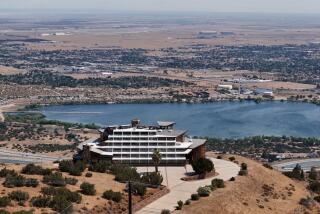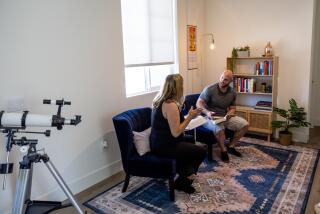Not so easy to flip
IF buyers have felt lonely making the sole bids on houses these days, it might be because home flippers, those who buy property with the intention of renovating and reselling quickly, haven’t been as active in the last year.
“Flipped” houses, considered by analysts to be those owned for six months or less, accounted for 3.2% of all home resales statewide in 2006, down from 4.2% in 2005, according to www.homesmartreports.com, a market-tracking website.
Flipping also proved less profitable last year as 24.9% of such sales resulted in a loss for the seller, compared with 7.5% in 2005. In 2006, flippers sold for a median $45,000 more than they paid (not factoring in improvement costs), down from $52,000 in 2005.
“The market where you could just go in, tidy something up and make a lot of money is gone,” said Jad Najjar, a longtime flipper and real estate broker in Beverly Hills. The number of his clients looking for houses to flip has declined 75% in the last year, he said, in part because it’s become a more rigorous and less profitable business right now and less experienced buyers fear a potential drop in the market. Najjar himself has had a 50% drop in profits from flipping since 2005.
Those who’ve continued to turn a profit say that although the margins are smaller and there’s less low-lying fruit, money can still be made with the right strategy. Investors have to look harder for “deals” and be more conservative about buying properties. Plus, they have to be savvier about the upgrades they make.
Charlotte Laws, a Prudential California, John Aaroe Realtor in the San Fernando Valley who works almost exclusively with flippers, said that suitable properties to flip have been harder to find over the last 12 months in part because she has become more conservative in what she might consider.
For a flip property in the $500,000 to $700,000 range, she said, she would want the potential profit (after closing and improvement costs) to be at least $80,000.
“Most of the properties I see now are not priced low enough for that,” Laws said. When estimating the post-renovation resale price, she subtracts 10%, a cushion in case the market falls by the time the property goes back on the market.
To find deals for clients, she said, she has been “focusing on property that has been on the market longer -- situations where the seller might be desperate, and we might be able to negotiate.”
Michael Corbett, a veteran home flipper, author of “Find It, Fix It and Flip It!” and host of the “Mansions & Millionaires” segment on TV’s “Extra,” recommends looking for property in historically low-priced areas that may be on the upswing.
In the Los Angeles area, he named Echo Park, Atwater Village, Culver City and Watts as neighborhoods with potential.
Although buyers can find lower prices in transitional neighborhoods, said Michael Richards, an agent in the Prudential California, John Aaroe office in Los Feliz who specializes in finding flip properties, they shouldn’t jump into new and unfamiliar territory too quickly in a softening market.
“Transitional markets can lag behind the better markets, and they are usually the areas that decline first” if the market goes down, he said.
Toby Donnelly, a contractor who has flipped more than 50 properties in the last seven years, also has become a lot pickier about what he will buy.
“All your profit is determined by how well you buy the property,” he said. He won’t purchase a house now unless he feels like he’s “stealing” it.
To hedge her bets, Debra Klein, an investor who has flipped 19 houses and condominiums in Los Angeles over the last eight years, always makes sure a property is rentable in the event it doesn’t resell quickly. “You have to make sure the rent you could get would cover your costs,” she said.
Many rental agencies and real estate brokers will provide free estimates and surveys of comparable homes for potential clients, services Klein used last year before she bought condominiums in Palm Desert and Indio. She is currently renting out those condos in addition to a house in Encino that she bought last year.
Although she’s covering her costs and making a profit on renting, she still plans to put all of the properties on the market in the next 12 months.
Once a property is purchased, flippers have to be careful about making the right kinds of upgrades for the neighborhood and for their budget. Agent Najjar, who flips houses in upscale areas such as Hancock Park, said that it’s become more important in this slower sales market to make high-caliber upgrades to appeal to buyers.
For example, Najjar said, he can’t just upgrade the kitchen counters without making sure that the cabinets are of the highest quality and that the appliances have name brands such as Viking and Miele.
You don’t want a buyer to open the cabinet and “see cheap material,” Najjar said.
Corbett advises investors to estimate the profit they want and work back from there in creating a renovation budget. But flippers have to be careful when estimating their sales price, making sure they don’t expect more than the highest comp in the area.
“If you go over your renovation budget, a soft market will not bail you out,” he said.
Investors should know that when doing their taxes, they can add any home improvements to the cost of the property, which is then subtracted from the sales proceeds and thereby reduces the amount taxable as capital gains, said Patrizia Copping, a certified public accountant and tax partner at Green Hasson & Janks LLP, a Westwood accounting firm.
Corbett concentrates on “lifestyle renovations” -- ones that can have big payoffs aesthetically. Increasing the perceived living space by adding a patio and putting in French doors to access the outside, for example, may help buyers visualize living and entertaining in the space.
He also advises adding elements to make a house stand out to potential buyers.
Spending an extra $150 for an elegant gooseneck faucet in the kitchen or an extra $200 on a fountain for the back patio are features that might catch a buyer’s eye or appeal to their emotions.
Making sure the house has up-to-date features, such as digital thermostats (which run about $40 to $80), and adding the latest technical devices, such as a video intercom system (starting at $120 to $180 for basic systems), can make buyers feel like they’re getting the most state-of-the-art home features.
But he warned against over-improving a house for the neighborhood. “You want to keep up with the Joneses and go one step ahead, but you don’t want to spend too much money and go over the top.”
Corbett visits open houses in the area or asks his real estate agent to find out what features the neighboring houses have.
Yet even with buying low and upgrading wisely, setting the right sales price is still key to successful flipping, said contractor-flipper Donnelly. “You have to accept that it’s a different market now and that you might not get the returns you want.”
During 2006, Donnelly had five properties on the market in Silver Lake in the $675,000 to-$700,000 range, none of which were selling. When he finally lowered the prices by about $15,000 to $20,000, he sold four of the five in a week.
Although market conditions can affect the level of profit, savvy flippers can still come out ahead.
“Even when prices are going up,” said John Karevoll, chief analyst for DataQuick Information Systems, a La Jolla-based real estate research firm, “the most successful flippers are the ones who can pounce on a deal.”
*
Jennifer Lisle can be reached at [email protected].
*
(BEGIN TEXT OF INFOBOX)
Neighborhoods worth flipping over
Each of these veteran flippers has a different strategy and opinion of which areas hold the most potential. Here are their choices.
Jad Najjar, real estate broker:
“I stick with more traditionally upscale areas.”
Hancock Park / Larchmont Village / Los Feliz
*
Charlotte Laws, real estate agent:
“I like ... more desirable neighborhoods. Homes sell faster there.”
Studio City / Valley Glen / Valley Village / Burbank
*
Michael Corbett, author, TV personality:
“I look at older homes in transitional areas.”
Echo Park / Atwater Village / Culver City / Watts
*
Michael Richards, real estate agent:
“These areas are gentrifying, so you can find good value there.”
Highland Park / Echo Park / Glassell Park
*
Toby Donnelly, contractor:
“I’ve always done well in these areas.”
Silver Lake / Long Beach / Torrance
-- Jennifer Lisle
More to Read
Inside the business of entertainment
The Wide Shot brings you news, analysis and insights on everything from streaming wars to production — and what it all means for the future.
You may occasionally receive promotional content from the Los Angeles Times.









